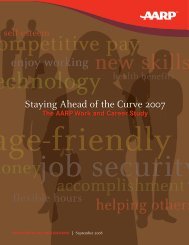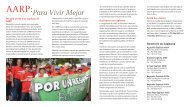The New Aging Enterprise - aarp
The New Aging Enterprise - aarp
The New Aging Enterprise - aarp
You also want an ePaper? Increase the reach of your titles
YUMPU automatically turns print PDFs into web optimized ePapers that Google loves.
RetirementJobs, along with other older worker job sites, seems well-positioned to<br />
capitalize on this major shift in the labor force, both in America and around the world. A report<br />
from the global consultancy firm Towers Perrin in 2007 has projected that, by 2016, 39% of the<br />
population in the Group of Seven (G7) industrialized nations will be aged 50 or more compared<br />
with 30% in 1996. During the same period, the proportion of the labor force in the traditional<br />
working age—15-49 years—is expected to fall from 51% in 1996 to 45% in 2016. In the USA,<br />
the same trend is visible. <strong>The</strong> U.S. Department of Labor’s Bureau of Labor Statistics reports that<br />
in 2000, 13% of the work force was over 55, but by 2010, the proportion is likely to rise to 17%.<br />
As noted, among aging Boomers themselves, nearly seven out of 10 tell AARP that they plan to<br />
work in some capacity in retirement.<br />
Idealist.Org is a web portal created 1995 by the international nonprofit group “Action<br />
Without Borders.” Idealist.org serves as a web-based channel for those interested in nonprofit<br />
organizations, issues, and careers, and specifically acts as a clearinghouse for paid employment<br />
and volunteer activities in the nonprofit world. Action Without Borders has a mission to connect<br />
people, organizations, and resources in order to “help build a world where all people can live free<br />
and dignified lives.” <strong>The</strong> organization’s methods have evolved over the years but the core focus<br />
has been on providing a meeting point for individuals and organizations seeking to improve their<br />
communities on both a local and global level.<br />
In earlier years, the group was called the “Contact Center Network” and focused on<br />
creating contact centers in local community sites. <strong>The</strong> idea was to create a physical meeting<br />
place where people could post messages, connect with neighbors, and share ideas for local<br />
action. In effect, such Contact Centers would be vehicles for promoting “social capital” along<br />
the lines outlined by Robert Putnam. 76 During the 1990s, the World Wide Web began to grow in<br />
scale and importance, so, in 1995, Action Without Borders relaunched the contact center<br />
approach as Idealist.org. <strong>The</strong> plan was to enable nonprofit groups to present a free<br />
organizational profile on the website and encourage contact. Organizations were also able to<br />
post openings for jobs and volunteer positions, while individuals could search the site and learn<br />
of job opportunities or share interests with others. Idealist also established a Nonprofit Career<br />
Center, featuring interviews with nonprofit leaders and offering career guidance about working<br />
in the sector.<br />
By 1999, more than 20,000 people were receiving Idealist daily email alerts, and more<br />
organizations were signing up. To support its work, Idealist began charging USA-based<br />
organizations a $40 fee for job postings, departing from the free listing practice up until that<br />
point. <strong>The</strong> result was an ongoing revenue stream enabling Idealist to enhance its programs and<br />
still keep most services free of charge. Although they did not intend to become known as a<br />
nonprofit jobs site, that is exactly what happened, and Idealist has gone on to become the most<br />
24










